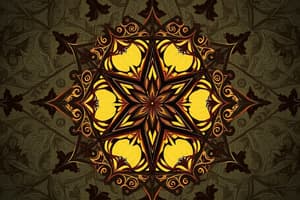Podcast
Questions and Answers
What type of quadrilateral has all four pairs of congruent sides forming right angles?
What type of quadrilateral has all four pairs of congruent sides forming right angles?
Square
Which quadrilateral has two pairs of non-parallel and non-congruent sides that meet at their endpoints?
Which quadrilateral has two pairs of non-parallel and non-congruent sides that meet at their endpoints?
Kite
How many pairs of parallel sides does a parallelogram have?
How many pairs of parallel sides does a parallelogram have?
Two
What distinguishes a rhombus from other quadrilaterals?
What distinguishes a rhombus from other quadrilaterals?
Which quadrilateral has opposite sides that are parallel and one side connecting both bases?
Which quadrilateral has opposite sides that are parallel and one side connecting both bases?
How many pairs of intersecting medians does a lozenge have?
How many pairs of intersecting medians does a lozenge have?
What kind of quadrilateral has all sides equal in length but not necessarily forming right angles?
What kind of quadrilateral has all sides equal in length but not necessarily forming right angles?
Which quadrilateral has opposite sides that are always parallel and never intersect?
Which quadrilateral has opposite sides that are always parallel and never intersect?
Flashcards are hidden until you start studying
Study Notes
A quadrilateral is any four-sided shape in geometry. It can have multiple properties depending on its sides' length and type, as well as angles between those sides. Some common types of quadrilaterals include squares, rectangles, parallelograms, trapezoids, kites, rhombuses, diamonds, and lozenges. Each of these shapes has specific characteristics, such as opposite parallel lines or equal adjacent sides, which set them apart from other quadrilaterals. For instance, a square is a special kind of rectangle because it possesses all four pairs of congruent sides forming right angles, whereas a triangle has only two pairs of congruent sides meeting at a vertex to form one angle. In contrast, a parallelogram has a pair of opposite sides that are always parallel and never intersecting, while a trapezoid has a base with opposite sides being parallel and one side connecting both bases. Kites consist of two pairs of non-parallel and non-congruent sides that meet at their endpoints, making up a total of four vertices. Rhombuses also contain three pairs of congruent sides arranged into a diamond shape. Lozenges resemble squares but have diagonals that bisect each other, resulting in four pairs of intersecting medians. Understanding the various kinds of quadrilaterals allows us to recognize different patterns within figures and apply this knowledge when solving geometric problems.
Studying That Suits You
Use AI to generate personalized quizzes and flashcards to suit your learning preferences.




